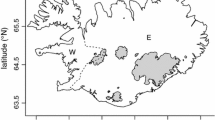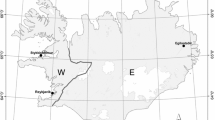Abstract
After a marked decline at the beginning of the 1900s, the arctic fox Alopex lagopus population in Fennoscandia has remained at a very low level. We suggest that the main cause for the population crash was winter starvation caused by (1) over-hunting of reindeer Rangifer tarandus populations, and thus reduced carcass availability in the mountains, and (2) increased interspecific competition for these carcasses because of increased invasion of red foxes Vulpes vulpes from lower altitudes. The failure of arctic fox populations to recover, despite increasing reindeer populations in the mid 1900s, can be explained by a concurrent strong increase in red fox numbers. Analyses of countywide hunting statistics from Norway 1891–1920 suggest that there actually was an increase in red fox numbers in the period of arctic fox decline, and that the increase in reindeer populations from the 1920s to the 1950s was accompanied by a new increase in red fox numbers. We conclude that restoring arctic fox populations most likely will require a substantial and lasting reduction of red fox populations.



Similar content being viewed by others
References
Angerbjörn A, Arvidson B, Norén E, Strömgren L, (1991) The effect of winter food on reproduction in the arctic fox, Alopex lagopus: a field experiment. J Anim Ecol 60:705–714
Angerbjörn A, Tannerfeldt M, Bjärvall A, Ericson M, From J, Norén E (1995) Dynamics of the arctic fox population in Sweden. Ann Zool Fenn 32:55–67
Angerbjörn A, Tannerfeldt M, Elmhagen B (2002) Presentasjon av SEFALO-prosjektet: Vilka chanser har fjällräven att överleva i Sverige? In: Rofstad G, Frafjord K, Fjellrev på Nordkalotten II. Nordkalottrådets Publikasjonsserie, Report no. 63
Angerbjörn A, Tannerfeldt M, Erlinge S (1999) Predator-prey relationships: arctic foxes and lemmings. J Anim Ecol 68:34–49
Bailey EP (1992) Red foxes, Vulpes vulpes, as biological control agents for introduced arctic foxes, Alopex lagopus, on Alaskan islands. Can Field-Nat 106:200–205
Boertje RD, Valkenburg P, McNay ME (1996) Increase in moose, caribou, and wolves following wolf control in Alaska. J Wildl Manage 60:474–489
Central Bureau of Statistics of Norway (1978) Hunting statistics 1846–1977. Oslo
Collet R (1912) Norges virveldyr. Bind 1, Norges pattedyr. Aschehoug, Kristiania (in Norwegian)
Curry-Lindahl K (1965) The plight of Scandinavia’s large carnivores. Animals 7:92–97
Dahl K (1927) Rovvildtet i vor jagthusholdning. Norges Jeger- og Fiskerforbunds Tidsskrift 56:369–377 (in Norwegian)
Frafjord K (2000) Do arctic foxes compete for food? Zeitschrift für Säugetierkunde 65:350–359
Frafjord K, Becker D, Angerbjörn A (1989) Interactions between arctic and red foxes in Scandinavia – predation and aggression. Arctic 42:354–356
Frafjord K, Spjøtvoll Ø, Lorentzen P, Grøneng T (1998) Dynamics of arctic fox reproduction in Børgefjell, Norway. Fauna 51:128–135 (in Norwegian, with English summary)
Hersteinsson P, Angerbjörn A, Frafjord K, Kaikusalo A (1989) The arctic fox in Fennoscandia and Iceland: management problems. Biol Cons 49:67–81
Hersteinsson P, Macdonald DW (1992) Interspecific competition and the geographical distribution of red and arctic foxes Vulpes vulpes and Alopex lagopus. Oikos 64:505–515
Hjeljord O (1980) Viltbiologi. Landbruksforlaget, Oslo (in Norwegian)
Høst P (1935) Trekk fra dyrelivet på Hardangervidda. Norges Jeger- og Fiskerforbunds Tidsskrift 64:201–211 (in Norwegian)
Jacobsen H, Andersen R (1990). Elgen. In: Semb-Johansson A, Frislid R (eds), Norges Dyr, Pattedyrene 2. Cappelen, Oslo, pp 104–127 (in Norwegian)
Jedrzejewska B, Jedrzejewski W (1998) Predation in vertebrate communities. The Bialowieza primeval forest as a case study. Ecological Studies 135, Springer, Berlin
Johnsen S (1929) Rovdyr- og rovfuglstatistikken i Norge. Bergens Museums Årbok, Naturvidenskapelig Rekke, 1929 (2) (in Norwegian)
Kaikusalo A, Angerbjörn A (1995) The arctic fox population in Finnish Lapland during 30 years, 1964–93. Ann Zool Fenn 32:69–77
Langvatn R (1990) Hjorten. In: Semb-Johansson A, Frislid R (eds), Norges Dyr, Pattedyrene 2. Cappelen, Oslo, pp 81–100 (in Norwegian)
Lindström E, Hörnfeldt B (1994) Vole cycles, snow depth and fox predation. Oikos 70:156–160
Linnell JDC, Odden J, Pedersen V, Andersen R (1998) Records of intra-guild predation by Eurasian Lynx, Lynx lynx. Can Field-Nat 112:707–708
Linnell JDC, Strand O, Loison A, Solberg EJ, Jordhøy P (1999a) Har fjellreven en framtid i Norge? Statusrapport og forslag til forvaltningsplan. NINA Oppdragsmelding 575:1–38 (in Norwegian)
Linnell JDC, Strand O, Landa A (1999b) Use of dens by red Vulpes vulpes and arctic foxes Alopex lagopus in alpine environments: Can inter-specific competition explain the non-recovery of Norwegian arctic fox populations? Wildl Biol 5:167–176
Löfgren S, Angerbjörn A (1997) Otgärdsprogram för fjällräv. Naturvårdsverket Rapport no. 620–9906 (In Swedish.)
Loison A, Strand O, Linnell JDC (2001) Effect of temporal variation in reproduction on models of population viability: a case study for remnant arctic fox (Alopex lagopus) populations in Scandinavia. Biol Cons 97:347–359
Lund HM-K (1963) Vilt og Viltstell no. 3. Reven. Småskrifter utgitt av Viltstyret og Statens Viltundersøkelser (in Norwegian)
Okarma H (1995) The trophic ecology of wolves and their prey predatory role in ungulate communities of forest ecosystems in Europe. Acta Ther 40:335–386
Selås V, Vik JO (2006) Possible impact of snow depth and ungulate carcasses on red fox (Vulpes vulpes) populations in Norway, 1897–1976. J Zool Lond 269:299–308
Siegel S, Castellan NJ (1988) Nonparametric statistics for the behavioral sciences. McGraw-Hill, New York, 399 pp
Skjenneberg S, Slagsvold L (1968) Reindriften og dens naturgrunnlag. Universitetsforlaget, Oslo (in Norwegian)
Skogland T (1990) Reinen. In: Semb-Johansson A, Frislid R (eds), Norges Dyr, Pattedyrene 2. Cappelen, Oslo, pp 148–170 (in Norwegian)
Strand O, Linnell JDC, Krogstad S, Landa A (1999) Dietary and reproductive responses of arctic foxes to changes in small rodent abundance. Arctic 52:272–278
Tannerfeldt M, Angerbjörn A (1998) Fluctuating resources and the evolution of litter size in the arctic fox. Oikos 83:545–559
Tomter SM (1994) Statistics of forest conditions and resources in Norway. Report, Norwegian Institute of Land Inventory, Ås
Acknowledgements
We thank Anders Angerbjörn, Olav Hjeljord, John Linnell, Anne Loison and Pål Prestrud for valuable comments on drafts of the manuscript.
Author information
Authors and Affiliations
Corresponding author
Rights and permissions
About this article
Cite this article
Selås, V., Vik, J.O. The arctic fox Alopex lagopus in Fennoscandia: a victim of human-induced changes in interspecific competition and predation?. Biodivers Conserv 16, 3575–3583 (2007). https://doi.org/10.1007/s10531-006-9118-6
Received:
Accepted:
Published:
Issue Date:
DOI: https://doi.org/10.1007/s10531-006-9118-6




